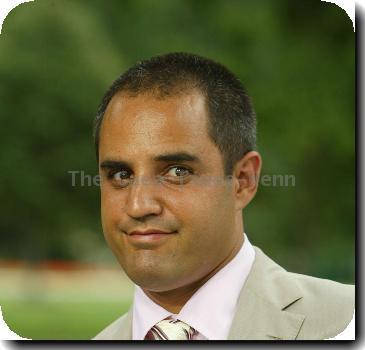After losing spring race to Kentucky, Atlanta gets set to become a one-race NASCAR town
By APSaturday, September 4, 2010
Atlanta gets ready to become a one-race town
HAMPTON, Ga. — This isn’t the way Atlanta Motor Speedway wanted to celebrate its 50th anniversary.
The high-banked track has traditionally hosted two NASCAR Sprint Cup races each year, but that’s changing in 2011. Track owner Speedway Motorsports Inc. decided to shift the attendance-challenged spring date to another of its facilities, Kentucky Motor Speedway.
As amazing as it may seem, Atlanta is about to become a one-race town — despite being one of the largest markets on the circuit and right in the heart of traditional NASCAR country.
“I started coming here in the 1980s,” said 51-year-old Mark Martin, the oldest regular driver in the series. “I love this place. I hate to see it come to that.”
He’s not the only one. The 1.54-mile quad-oval has long been one of the most popular in the series among the drivers, who love its hair-raising speed and multiple passing grooves.
“I wish we raced Atlanta every other week, maybe three times a month,” Carl Edwards said. “I really, really like this place.”
But there’s more to racing than just racing.
The spring event at Atlanta was traditionally plagued by poor weather and struggled to draw fans. Track officials tried all sorts of marketing gimmicks and even slashed ticket prices, but nothing helped. Finally, SMI owner Bruton Smith had to make a hard business decision: If he wanted a Cup race at Kentucky, it would have to come at the expense of another of his tracks.
Atlanta was the most logical candidate, despite its long, proud Cup history.
“There’s no way you’re going to convince me this decisions was done because we’re the worst market,” track president Ed Clark said. “It was simply who owned what, and a choice had to be made. Bruton ran out of options. There was no other thing he could do.”
Still, there’s no denying all those empty seats. Even the race Sunday night, the Labor Day weekend event that Atlanta will be keeping in 2011, isn’t expected to be a sellout.
“It’s unfortunate, but it’s necessary,” Kyle Busch said. “When you can’t sell seats, you don’t deserve to go to that race track twice. It’s all about getting butts in the seats.”
NASCAR has juggled its schedule dramatically over the past decade, delving into new markets that go beyond its Southern roots. Darlington, the most historic track on the circuit, lost one of its two races in 2005. North Wilkesboro and Rockingham were kicked off the circuit altogether.
The newer tracks aren’t guaranteed their events either. As part of the scheduling shake-up for 2011, NASCAR also took away a race from California Speedway near Los Angeles, plagued by thousands of empty seats despite being the second-largest market in the country, and gave it to Kansas Speedway.
“We go to some places that might not be so exciting of a race,” Busch said. “But the infield looks great because there’s a lot of people there. The grandstands look good because there’s a lot of people sitting there. That’s why racetracks keep their races. If you don’t have support in a given area of the country, it ain’t going to last. California’s in the same boat. How many million people live around California? But they can’t fill the race track.”
Atlanta International Raceway, located about 20 miles south of its namesake city, opened on July 31, 1960, as a 1½-mile oval. Fireball Roberts won the very first race, the Dixie 300. The inaugural Atlanta 500 was held later that year and a tradition was born.
There were actually three races in 1961 — a 500-miler, a 400-miler and a 250-miler — but by 1967, the track had settled into its tradition of hosting two 500-mile races each year. That included the coveted final race of the season and the crowning of the Cup champion.
“The sad part in all this is that so much of what our sport is started right here in north Georgia,” Clark said. “At one time, Atlanta was the hub — not Charlotte. That got away, and now this race date is getting away.”
He wonders if the sport is losing something by turning away from its traditional base, and he’s heard from plenty of disgruntled fans who feel that way.
“Based on some of the conversations I’ve had, there’s some ill feelings about that,” Clark said. “I don’t think it’s being directed at us, because I certainly hope nobody thinks Atlanta Motor Speedway wanted to lose a date. But it seems like the base of events and tracks has eroded over time in the Southeast. You can call that progress, you can call that whatever … but it’s hard for fans to take.”
Clark said he’s determined to build the Labor Day race into a coveted ticket that shows Atlanta is still one of NASCAR’s top markets. Next year, there will be three races held on successive nights covering all of NASCAR’s series: trucks, Nationwide and Sprint Cup.
He’s also pursuing a major event to fill the springtime void. Atlanta was a stop on the Indy Racing League schedule from 1998-2001 but never built up much of a fan base. With the merger in open-wheel racing and a new president running that series, Clark said he might take another look at IndyCar.
“I don’t even know if it’s an option. I haven’t had any conversations with them,” he said. “But they’ve got a good product, and they do well in some of their other venues. We haven’t had them in eight or nine years, and everything has changed over there since they were here.”
Clark said he might also consider a non-motorsports event, such as music festival or hot air balloon race.
Of course, he would love nothing more than for NASCAR to decide there is a place for a second Atlanta race on the schedule.
“That’s certainly not something we will ever turn our back on,” Clark said. “Our hope is that if we did get our race back, it would be on a better date so we could really show our potential.”
Tags: Atlanta, Automobile Racing, California, Carl Edwards, Georgia, Hampton, Holidays, Indycar, Kentucky, Nascar, North America, Occasions, Sports, United States


